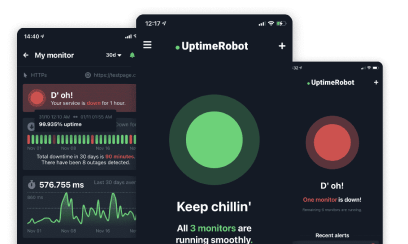Quick links
As a website owner, there’s nothing worse than seeing a potential sale slip through your fingers because of a site outage. Imagine a customer eagerly browsing your online store, ready to make a purchase they’ve been eyeing for weeks. And then … the site won’t load.
How quickly do you think those potential customers will click away and go buy the same product elsewhere? 10 seconds? One website refresh later?
For most people, it’s a lot less than that. Kissmetrics says the average website visitor will move on in just 3 seconds if they can’t access a site. But the consequences of website downtime don’t end there.
A whopping 79% of shoppers who are unhappy with a website’s performance are unlikely to return, and 44% will tell others about their bad experience with a particular website. The result? One single event of website downtime can result in many lost sales for months to come.
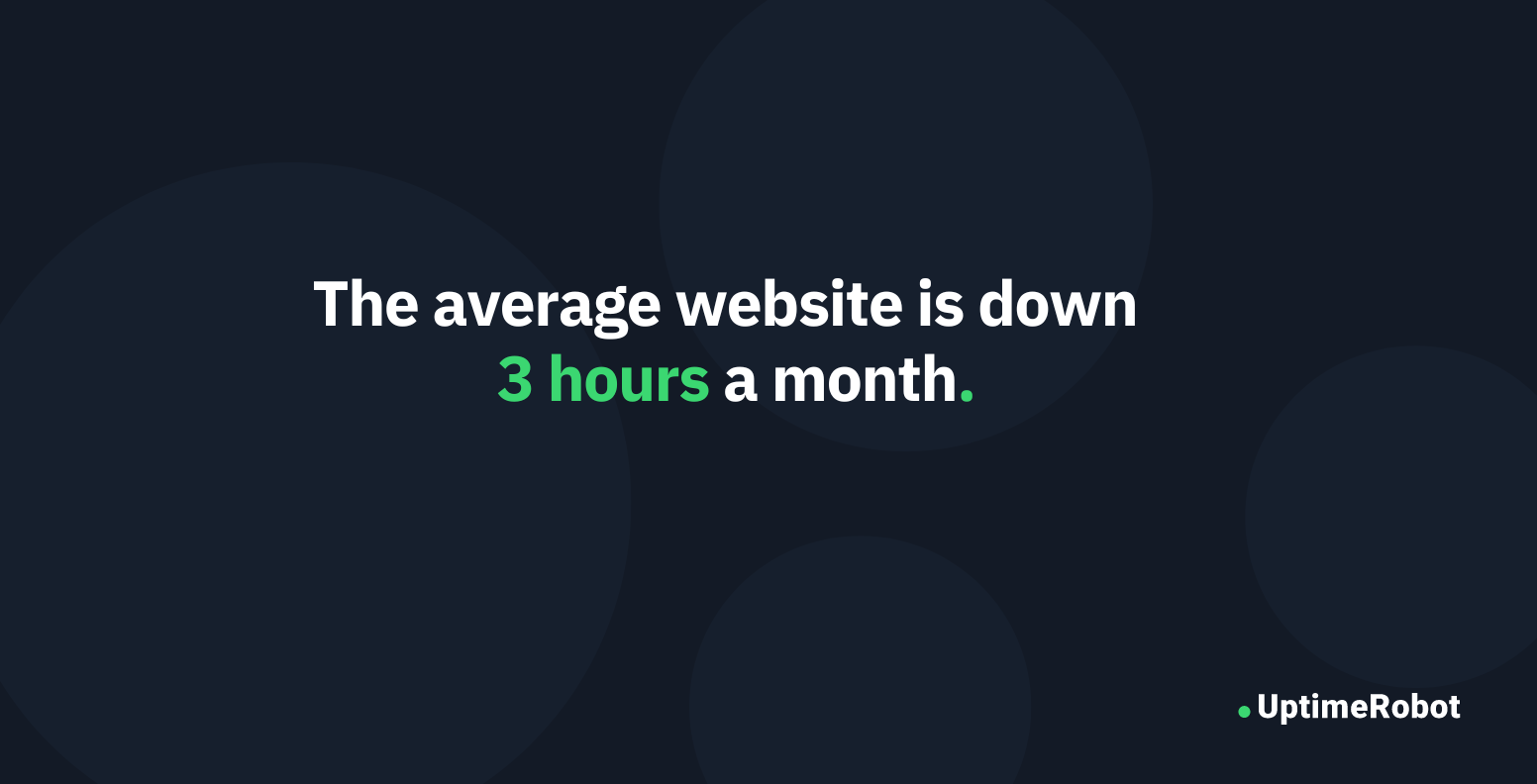
The average website experiences three hours of host downtime every month and 760 outages every year, according to research conducted by Hosting Facts. Sometimes the downtime is so short (minutes at a time) that you might not even notice it — but that doesn’t mean it’ll go undetected by your current clients or prospects.
In this article, we’ll talk about why website downtime can have a massive negative impact on your business and reputation and what you can do to prevent it. So, grab a cup of coffee and let’s dive in!
What Happens When Your Website Is Down?
Website downtime can be a significant problem for businesses. If your site is inaccessible to users, they may be unable to make purchases, get in touch with you for customer support, or access important information. While a few minutes of downtime here and there might not sound too damaging at first, the numbers tell a different story.
In 2017, Amazon suffered an S3 cloud outage that lasted for several hours and affected a large number of companies that depend on Amazon’s cloud services. Everybody from Apple and Venmo to Slack, Trello, and many individual sites lost power too, according to NPR. Estimates from Data Center Knowledge put the total financial cost of the outage at over $150 million.
But website downtime can also cause deeper issues, like affecting your business’s search engine ranking, reducing your overall traffic, and damaging your company’s reputation and customer loyalty. According to Kissmetrics, “a 1-second delay (or 3 seconds of waiting) decreases customer satisfaction by about 16%.”
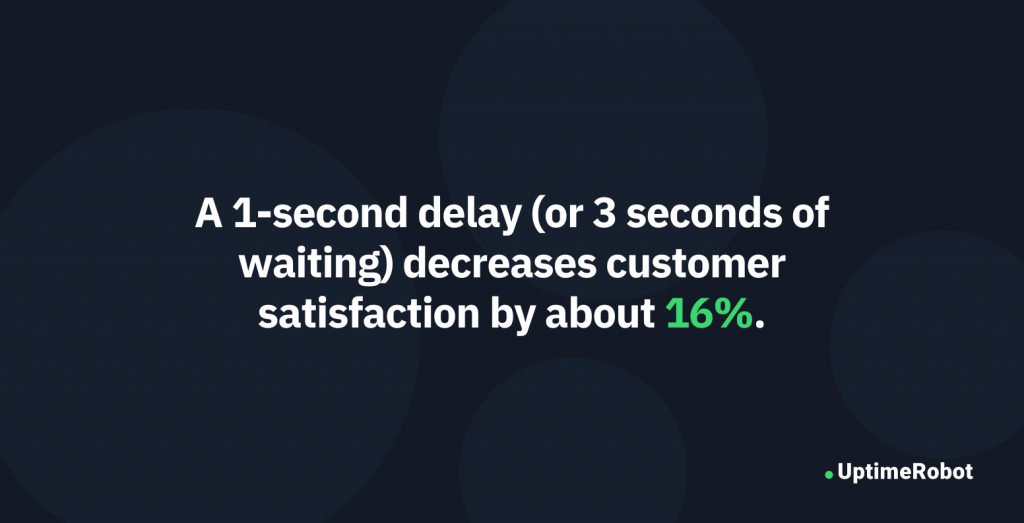
6 Common Reasons For Website Downtime
From server failures to cyber attacks, there are various reasons why websites experience downtime.
1. Server Maintenance
Perhaps the most common reason for website downtime is server connection failure. Servers go down for many reasons, including regular maintenance or resets, repairs, and upgrades. All of these can cause downtime.
There isn’t much you can do about scheduled planned outages coming from your server, but if you’re the one performing maintenance or upgrades you should at least make sure you schedule these events during periods of low website traffic. Doing so will help you reduce the impact of downtime.
ScalaHosting also recommends performing full security server audits at least once or twice per year, but also having a weekly and monthly maintenance schedule for smaller tasks.
You should also announce in advance any planned outages so your users are aware of upcoming maintenance and incidents. A status page is an easy way to keep everyone updated about the status of your website and can help protect your reputation as a reliable company. If you have a planned outage, you can also use the Maintenance Window feature (under My Settings) to set up the time your website will be offline so UptimeRobot won’t send requests to your server during that time.
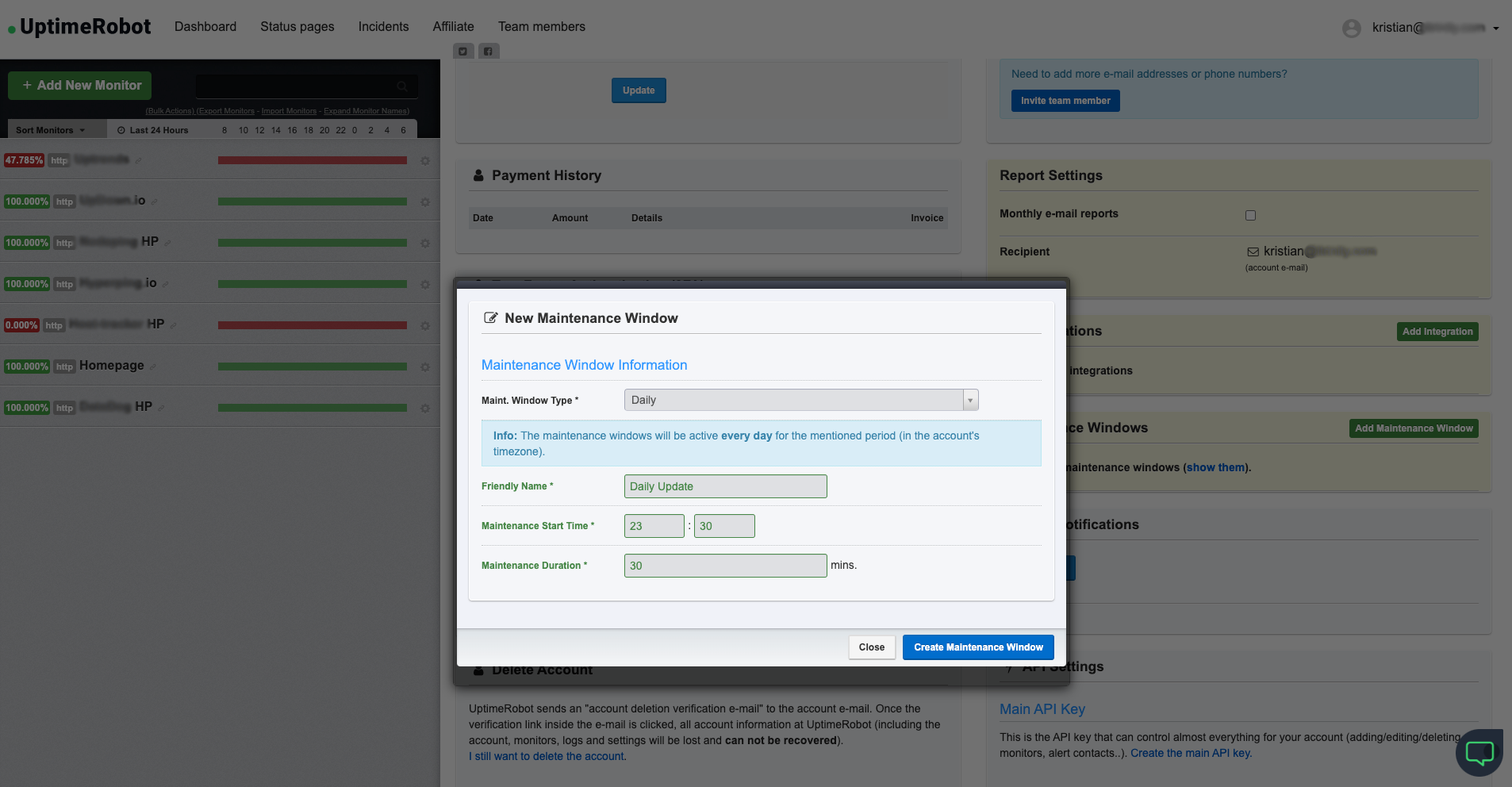
2. Server Overload
A popular website or a recently viral post or product is another common reason for downtime. Traffic like this can cause the server to crash or slow to a stop.
There is no quick fix for this issue. The good news, of course, is that this means your website is popular — which hopefully is translating into lots of sales or new clients. Step one to dealing with this is making sure you’re using an uptime monitoring tool.
This will allow you to check your website at one-minute intervals (or 30 seconds in our Enterprise plan) so you can be notified right away when something goes wrong. If you’re experiencing server overload and downtime frequently, you might need to invest in a better hosting plan that can adequately handle your website’s traffic.
The Monitor Timeout feature from UptimeRobot creates an incident and alerts you when there is a connection timeout longer than the defined value.
For large companies, a content delivery network or CDN, which distributes your website’s content across multiple servers, might be worth considering. This reduces the load on any one server, in turn making crashes less likely.
You should also look into additional steps, including optimizing database queries, optimizing website code, using load balancing or rate limiting, and updating hardware (more CPU and RAM) if it’s your own dedicated server.
Two major examples of website downtime due to server crashes happened in 2022. The first one was in January, when cryptocurrency exchange platform Coinbase ran an ad during the Super Bowl. The ad included a QR code that people could scan to access a promotion page offering $15 in Bitcoin to anybody who signed up for an account during a limited time. The result? 20 million people scanned the app in one minute, causing the Coinbase website to go down for one hour.
The second famous crash happened in October, when Spotify released Taylor Swift’s new album. The highly anticipated album caused a frenzy among fans, which resulted in nearly 8,000 reported outages.
The moral of the story? Even the big players might be unable to completely stop server crashes, but if you’re anticipating a major event or promotion, it pays to be prepared.
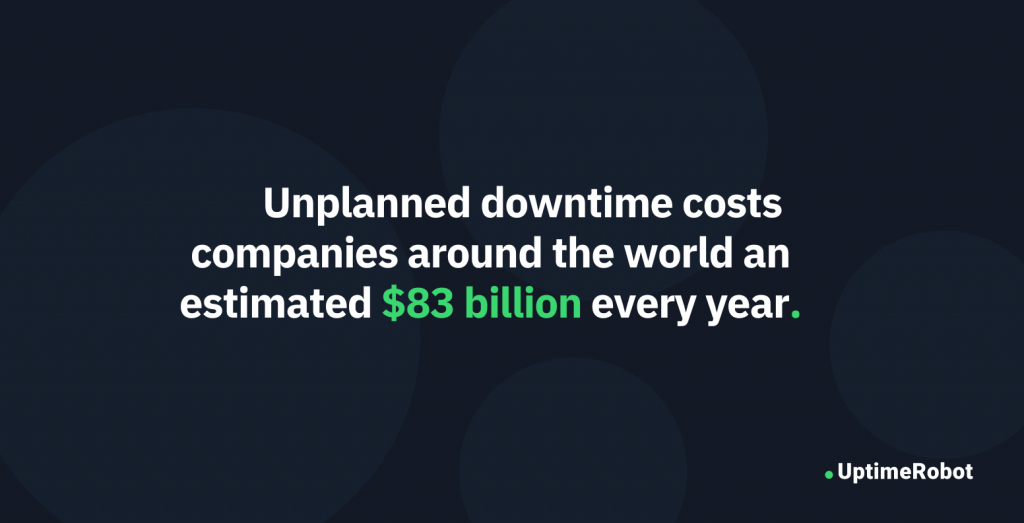
3. Hardware Failure
Another common reason for website downtime is hardware failure. Although both hardware and software have become increasingly reliable over the past ten years, the risk of component failure still exists. Aging hardware can crash or be overloaded, but it can also lead to slow response time and random short system failures.
Even something as simple as the interruption of power supply or overheating can affect your server. In some cases, using a VPN can help identify whether the issue is local or more widespread, especially if the downtime appears region-specific. While data centers are usually well protected against power outages, disks can still fail due to technical reasons or human error. This isn’t as rare as you might think either. The Uptime Institute’s 2022 Outage Analysis estimates that 43% of the outages affecting data center operators are caused by power supply (UPS) failures.
Even something as simple as an update of drivers and firmware can crash a site.
4. Cyber Attacks
Cyber attacks, including malware infections, can also cause website downtime and are more common than you think. According to cybersecurity firm Cobalt, there are an estimated 2,220 cyberattacks each day (or over 800,000 attacks every year). Regular virus removal can help protect against such disruptions. The impact is often long-term as well, with pro-consumer website CompariTech estimating that public companies experience poor stock performance and see a loss of 8.6% of their value after a cyber attack.
These attacks can take several forms, including DDoS attacks, where false website access requests are sent in very large numbers to try to crash the server. Cross-site scripting (XSS) attacks —which inject malicious scripts into trusted websites— are another server-side vulnerability that can also disrupt a website’s normal operations.
5. Releases or Updates to Your Website
Regular website updates are important to minimize errors and lower security vulnerabilities, but they can also cause errors.
Even basic things like adding or removing 3rd party integrations and plugins, updating security patches and CMS versions, or upgrading JavaScript files can also cause website downtime. This often happens when the updates conflict with existing software or there’s an issue during the installation process.
Regular updates (rather than waiting a long time to update and then installing too many things at once) can make it easier to spot and correct errors.
6. Human Error
Let’s face it: humans aren’t perfect. And when you mix humans and machines … well, chances are something will go wrong. In fact, according to the Uptime Institute’s 2022 Outage Analysis, they go wrong a lot — 40% of the significant outages (defined as those that cause both downtime and financial loss) over the past three years were caused by human error.
Human error can take many forms. For example, neglecting to update things regularly (as mentioned above) falls under human error, and so does misconfiguration of server hardware and applications, poor performing maintenance, and choosing the wrong size server (especially if you’ve recently upgraded to a more intensive workload).
Remember that 2017 Amazon outage that cost the company millions of dollars? It was due to human error. A member of the Amazon Simple Storage Service (S3) team executed the wrong command during a routine debugging exercise, as reported via Data Center Knowledge.
There are plenty of automation tools you can use to reduce the risk of human error, but it’s also important that anybody in the role of website administrator is properly trained to ensure best practices when performing website maintenance.
Is There Anything You Can Do To Prevent Website Downtime?
While some things might be out of your hands (like an electric storm shutting down your server), there are always things you can do to minimize damage even if your website does go down. But there are also plenty of precautionary steps website owners can take to lower their chances of website downtime.
Start by choosing a reliable web hosting service
Stable network connections are the foundation of your website’s performance. A hosting service with a poor record of reliable uptime or low loading speeds is a recipe for disaster.
Look for hosting companies who offer cheap dedicated hosting with an annual uptime score of at least 99.5% — but don’t just take their word for it. You can use an uptime monitoring tool to check your hosting service and see if it performs at the level promised when you signed up.
Regularly perform backups of your website data
This is especially important in the case of a cyber-attack or a major hardware failure, as you’ll be able to restore your website quickly and minimize the negative impacts of downtime.
Don’t forget to implement a disaster recovery plan
This includes the backups already mentioned, but also other steps you need to take in order to recover data, replace your server, and communicate with users or clients to keep them updated.
Make sure you have a Web Application Firewall (WAF) in place
While no WAF is perfect, having one in place can help protect your website from downtime caused by attacks and vulnerabilities, malicious traffic, and security misconfigurations.
Regularly monitor server logs
Don’t underestimate the importance of keeping an eye on your server logs — they can help you identify issues that might lead to downtime, including server overload. Specific server monitoring tools can also help track server responsiveness, capacity, and speed so you can be alerted early if issues arise.
Consider using a Content Delivery Network (CDN)
A CDN isn’t for everybody, but for large sites or sites that regularly handle high levels of traffic, a CDN can help reduce the page load time, minimize server overload, and bring down bandwidth.
Regardless of which steps from the list you decide to try, it’s always a good idea to use an uptime monitoring tool like UptimeRobot. These won’t actually prevent downtime, but they will alert you if your website goes offline by monitoring the website from multiple locations and providing detailed reports on website uptime and performance. They’re a great resource to understand what’s happening to your site so you can then take action immediately.
Conduct a Post-mortem
A post-mortem analysis can help a business avoid downtime by providing insights into the root cause of any incident. UptimeRobot, for example, provides an option to add comments on incidents which can help in identifying patterns and taking necessary actions to avoid similar situations in the future.
What an Uptime Monitoring Tool Can Do For You
Website downtime can be connected to many different issues both on the client and the server side. But even if you notice your website is down, without a proper monitoring tool to identify specific errors, you still would not be able to tell WHY this is happening.
Some of the most common errors connected to website downtime that UptimeRobot can identify include:
- 403 Forbidden. A client-side error often related to a configuration issue that prevents the server from handling your request. Could be caused by a malware infection or a missing index page.
- 404 Not Found. This very common HTTP status is an indication that the server can’t locate a specific URL. Possible causes include a misconfigured redirect, DNS settings issue, or a broken link.
- 501 Not Implemented. Happens when the server doesn’t recognize or doesn’t have the functionality required to handle a request. Fixing this error can be as simple as reloading the page or disabling proxy settings, but you might also need to reach out to your web server to see if an update or server overloading caused the problem.
- 502 Bad Gateway. The most common cause for this error is an invalid response from a server in a network path, but it can also be due to overload or proxy issues.
- 503 Service Unavailable. A common server-side error when a server is temporarily overloaded or down for any reason and is not ready to handle a request. In some cases, it might indicate a server connectivity issue or an improper firewall configuration.
- Connection Timeout. An error that indicates the website took too long (usually over 30 seconds) to respond to the browser’s request.
- SSL Expiration. Appears when the validity period of the SSL certificate has expired.
Never underestimate the significant impact website downtime can have on your business. Understanding the most common causes of website downtime is just the first step — you also need to take steps to ensure website uptime and maintain a positive site reputation.
